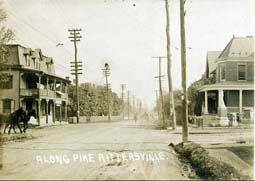
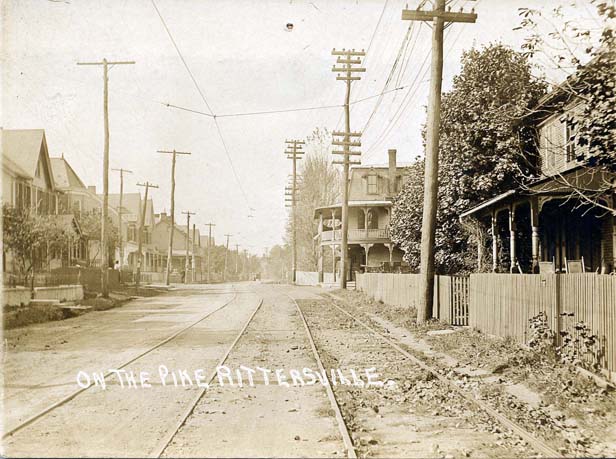
|
|
|
Rittersville - 1907: Looking east from Tacoma St (in right foreground) |
Rittersville - 1907: Looking west toward Tacoma St (entering Hanover Ave at the middle left of the photo) |
The years 1900 to 1910 saw significant growth in Rittersville, more than in all the previous years combined. In 1900, George Weisel established his granite and marble works at what is now 2004 Hanover Ave. The house still stands at that location. Also in 1900, Samuel Solliday started his photography studio at Central Park.
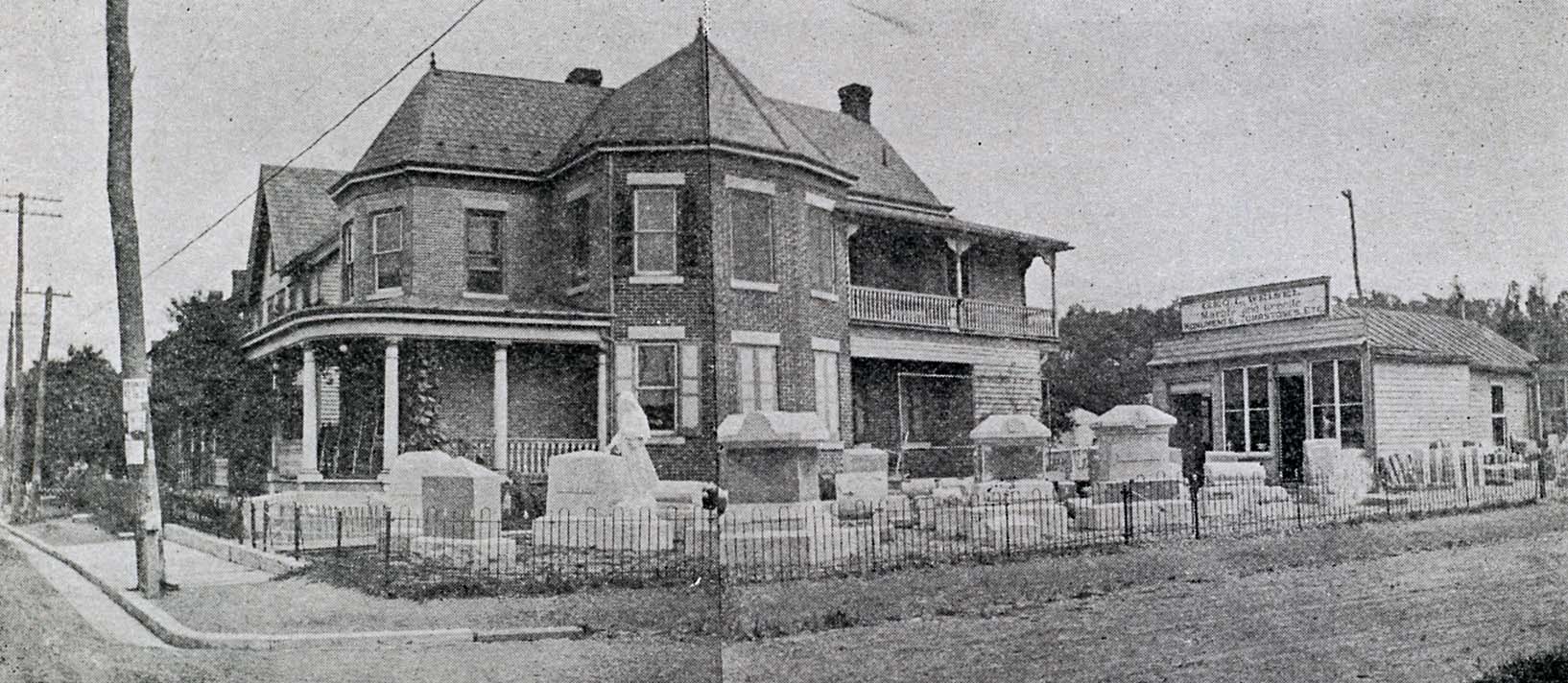
|
|
|
By 1903, there were four hotels in Rittersville. Besides the Manhattan and Hanover Hotels, there was the American Hotel which was located across the street from George Weisel's business. In 1903, the hotel was owned by Otto Diener. By 1910, it was being managed by John Mentzell. When the hotel was built and how long it remained operating is unknown, but it was still operating in 1919.
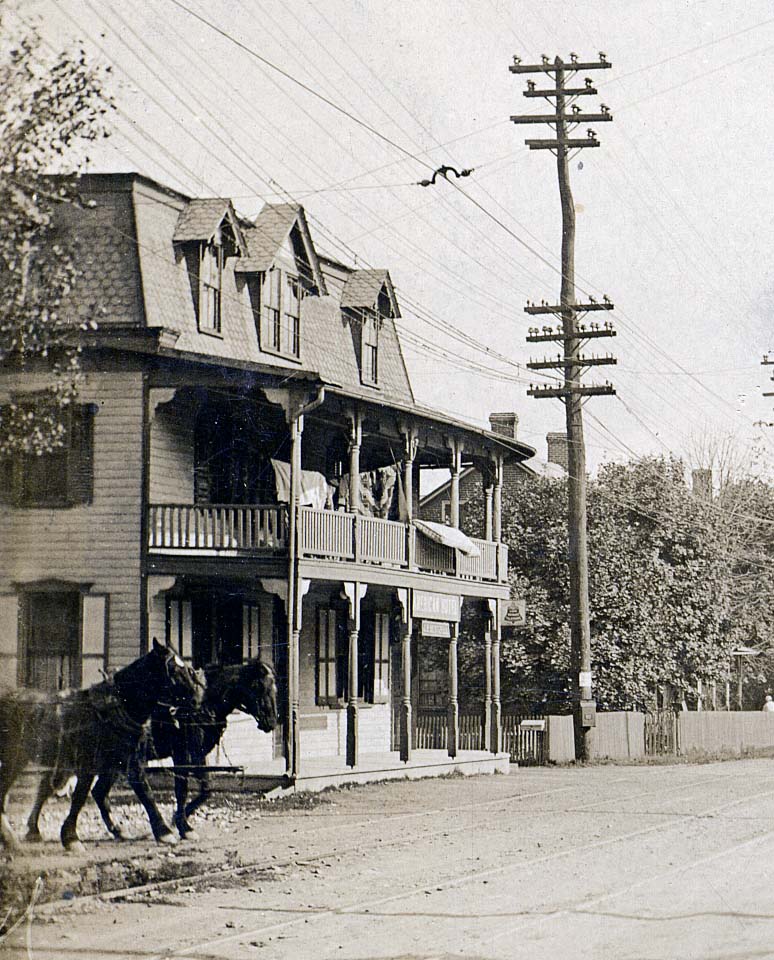
The fourth hotel was the Melrose Hotel, which was located on the northwest corner of Hanover Ave and Melrose Ave (today's Nelson St.), where Walgreen's is today. In 1903, it was managed by Jeremiah Gauff. It is also unknown when this hotel was first established, but by 1911, it had been purchased and converted to a knitting mill. An interesting sidelight about the owner of the hotel, Jeremiah Gauff: in 1880, Gauff owned a hotel or boarding house in West Bethlehem. At the time of the 1880 census, eight of Gauff's boarders defined their occupation as "prostitute". Kind of makes one wonder about the clientele of the Melrose Hotel. In fact, in January of 1908, Mr. Gauff did have his liquor license revoked for conducting a house for immoral purposes.
During the early 1900's, one of the biggest factor's in the growth of Rittersville was real estate development. Rittersville was basically a village surrounded by farms. As was happening throughout much of the United States, as the economy became more industrialized, farmers and their families realized that a better life could be had by selling their farmlands, moving to the cities and villages and working in the new industries. Rittersville followed this pattern, and the person responsible for most of the early real estate development in Rittersville was Dr. Robert B Klotz. If Michael Ritter was the founder of Rittersville, then Dr Klotz was its father, for it was he who nurtured its growth and had a vision for the village's future. (see Dr Robert B Klotz)
You can see the real estate development during this first decade by examining a 1909 map of Rittersville.
Dr. Klotz was not the only real estate developer in Rittersville. Another person responsible for the growth of residential housing in Rittersville was Joseph F. Gorman, an Allentown banker and financier. Between 1906 and 1910, Mr. Gorman was responsible for developing more than 1,500 residential building lots in Rittersville, including the area labeled as "Manhattan Park" on the 1909 real estate map.
While this development was taking place, other events were occurring in Rittersville, as well. One of these was the laying of the cornerstone of the Homeopathic State Hospital for the Insane. It was located on 209 acres that had been the Sterner farm. By 1904, however, this land had been sold in tracts to 9 different owners. Like the Sterner farmlands, the state lands ran from Hanover Ave. south to the Central Railroad tracks adjacent to the Lehigh Canal. Due to inadequate state funding, graft and corruption, the hospital was not completed until 1912. The hospital became a large employer in the area, and just as the name Rittersville was associated with Central Park, it also became associated with the State Hospital. It was not uncommon for people to say that if someone was acting crazy, they were going to be sent to Rittersville, meaning, of course, the mental hospital.
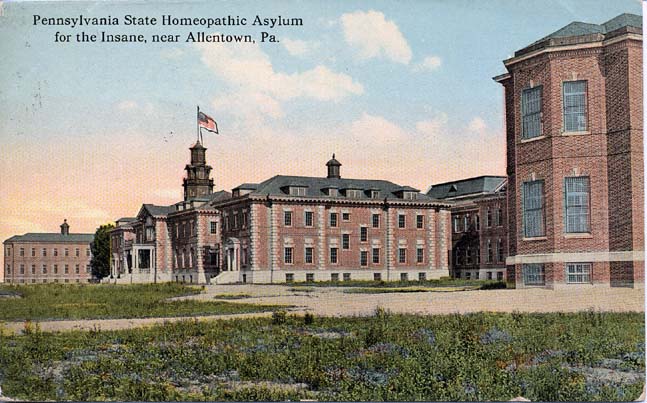
Also in 1904, the Holiness Camp Meeting Association was replaced by the Beulah Park Camp Meeting Association which established 8 permanent buildings on the site, including a pavilion for 1,500 people, a dormitory with 36 rooms, a large dining hall, and cottages. They also drilled a 156' well. This site eventually became the site of the Beulah Park Bible Institute, and later, Eastern Pilgrim College. It is now home to another religious organization.
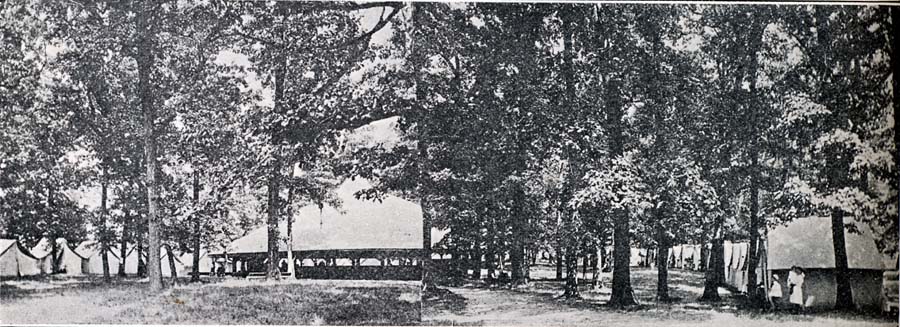
In 1904, previously incorporated West Bethlehem was annexed by the City of Bethlehem. Officially, West Bethlehem was originally incorporated only as far west as 5th Ave. Many of the residents west of 5th Ave. still considered themselves part of Rittersville, as evidenced by the addresses reported in the Allentown city directories from various years between West Bethlehem's annexation and 1920, when Rittersville was annexed by Allentown. This was particularly true of residents living in the Elliott Heights section of West Bethlehem.
On November 16, 1905, Rittersville experienced a devastating fire that destroyed six homes along the north side of Hanover Ave. in what, today, is the 2000 block. Thirty people were rendered homeless. This fire demonstrated the need for a fire company in Rittersville and a company was organized on December 18, 1905, a little more than a month after the fire. (see Rittersville Fire Company)
|
|
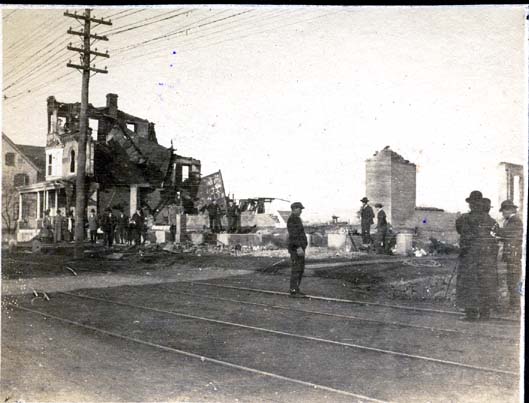 |
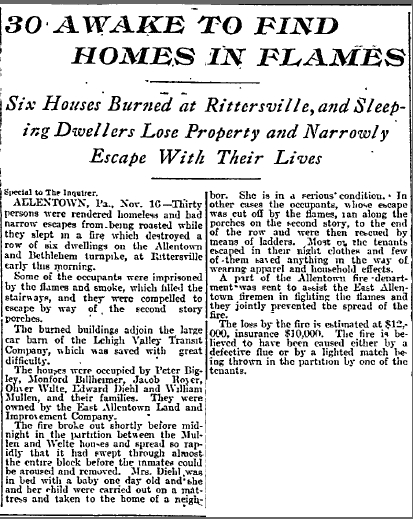
Philadelphia Inquirer, Nov 17, 1905
|
The Allentown
Morning Call, Allentown, Pa., November 17, 1905 BLAZE WIPES OUT
SEVEN HOUSES ---
Equal Number of Families Rendered
Homeless by Destructive Blaze at Rittersville ---Narrow Escape of Thirty
Tenants of the Homes --- Fire Originated From Spark of Match --- Small
Insurance to Cover Loss Seven families were
made homeless and a block of as many houses destroyed by fire late last
night at Rittersville, when a spark from a match, lodging in the carpet
of the home of Israel Miller, along the Allentown-Bethlehem pike,
smoldered for a time and then broke out in flame, causing the most
disastrous fire that that village has even known. The Miller family had
retired a short time before, and nearly every person residing in the
block had retired, when Mrs. Oliver Welte, wife of the barber, noticed
the smell of smoke. Hurriedly arousing her
husband, an investigation was made.
The flames were found to have burned their way almost through the
studding walls which separate the houses, and the crackling of flames
could be heard on the other side, when Mr. Welte aroused the Miller
family. The entire
neighborhood was soon awakened, and all hastened to assist the
unfortunates whose homes were soon to be doomed in removing what
property could be carried out of the houses. The Welte house is the
next one to the car barn, and the fire, which started in the second
house, rapidly communicated to it, and to the house next towards this
city, owned by John Shoemaker, and tenanted by a family named Royer.
The next house is owned by William Mullen, and tenanted by
himself. The upper three
houses are the property of Peter Bigley, who occupied one, and had
rented the other two to Monford Billheimer and Ed. Diehl, respectively.
Each home is valued at $1800, and the corner house at $300 more. They were erected two
years ago by the East Allentown Improvement Company, a co-operative
organization, and most of the owners had nearly paid off their homes
when they were destroyed.
|
The fire was not
without its heroic side.
Several rescues of sleeping persons were made in the nick of time, and
Mrs. Diehl, wife of the lineman of the Traction Company, and her
two-weeks-old son were gotten out of the house just in time by Mr. Diehl
and Ed. Appel. Several
families were compelled to escape by way of the porch roofs, the stairs
having already caught fire. None of the houses were
insured to their full value, and in every case, while the contents are
insured, the tenants will lose considerable. The heat of the fire
blistered the paint on the house tenanted by Joseph Knoll, nearly a
hundred feet away, and the firemen had a difficult time keeping the
flames from this house and that of Mrs. Mary Acker. Nearly thirty persons
were made homeless by the fire, and in several cases, the results of a
lifetime’s savings went up in smoke.
One man stated that he had left a considerable amount of money in
a bureau drawer when he was forced to leave by the flames, and others
bemoaned the loss of money and valuable papers which they were unable to
rescue from the fire. The families were given
temporary shelter by the neighbors, who did all in their power to assist
them in removing what personal effects they could before the fire became
too fierce. The walls fell one
after another shortly after midnight. |
The year 1906 saw Rittersville get its first manufacturing industry. In January of that year, the firm of Klotz & Bregenzer was organized and started the manufacture of silk ribbons with two looms in an old barn on the former Frank Texter farm. Business increased quickly and Dr Klotz and Edwin Bregenzer saw the need to move to a larger location. They erected a brick building in 1907, and moved in early the following year. In 1914, they employed 35 people and had 19 looms. The Klotz and Bregenzer building, though enlarged from its initial size, stands today behind the Rittersville Fire Company building.
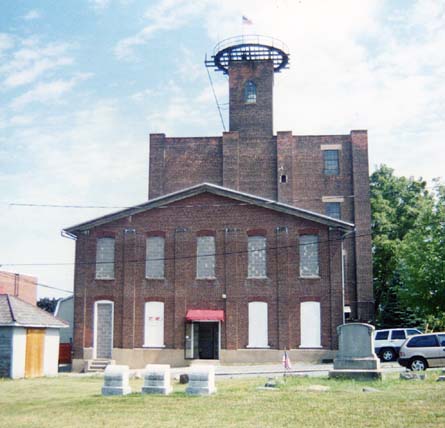
Also in 1906, Dr Klotz built his residence on Hanover Ave, and was located only two houses away from his partner, Edwin Brenzeger.
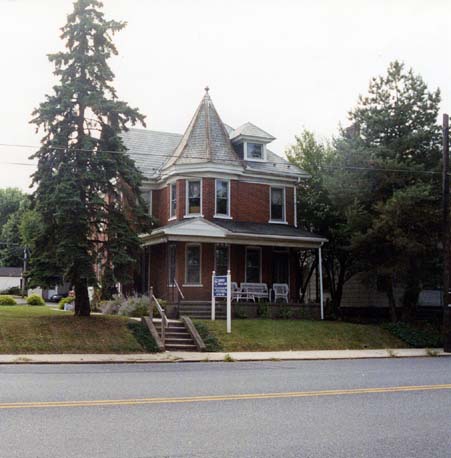 |
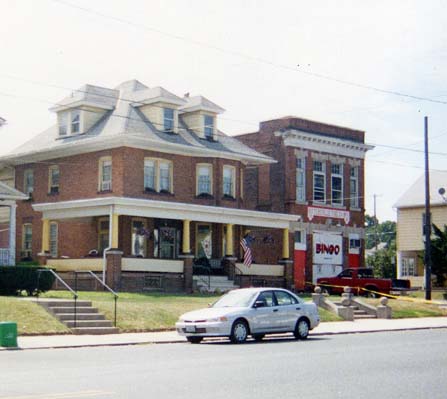 |
The Klotz House |
The Bregenzer House |
1907 saw the turnpike road condemned by the state and tolls were no longer collected. It was also in this year that a new two-story, four classroom school was built on Tacoma St. It occupied what is now the vacant lot across the street from the present-day church. Dr Klotz, as a director of the school board, was largely responsible for getting this new school built.
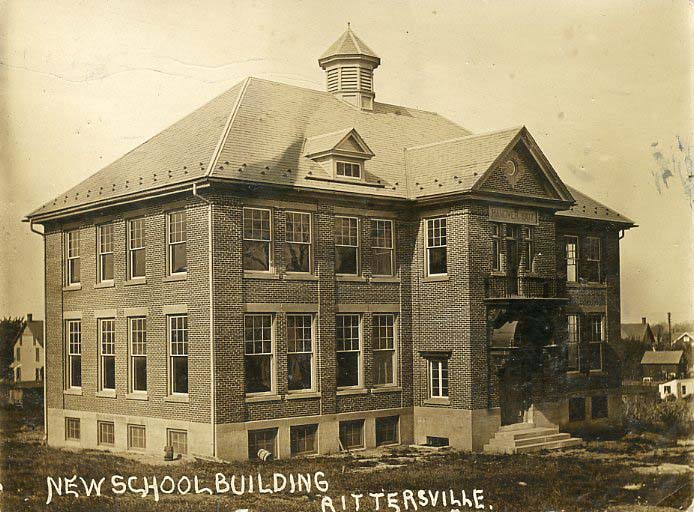
Dr Klotz also persuaded the Bethlehem City Water Company to extend its mains into Rittersville, which they did extend to Melrose Ave., (Nelson St today). Thus, for the first time, Rittersville residents could get city water. Dr Klotz was so successful in this endeavor that the community of East Allentown asked him to have the Bethlehem mains extended to their community the following year. It was also in the year 1907, that Dr Klotz, due to failing health and the need to concentrate on his real estate businesses, sold his medical practice to Dr Victor J Gangewere, Rittersville's second physician. Dr Gangewere moved into a residence across the street from Dr Klotz.
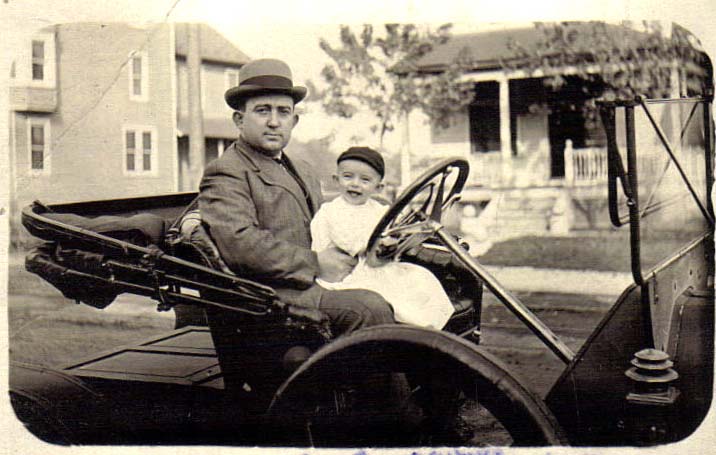 |
|
|
Dr Victor Gangewere Photo © Donna Walter Szakal |
Dr Gangewere's Residence Today |
Rittersville's second industry was organized on September 1, 1910, when Herman Hildebrand and Elmer Osenbach formed the firm of Hildebrand & Osenbach to manufacture hosiery. Their manufacturing plant was located just to the east of Klotz & Bregenzer, next to Central Park. By 1914, they employed 25 people.
In the latter part of 1910, the Lehigh Country Club came into existence. A 60 acre plot of land known as the Dodson farm, was purchased and the following year, work began on building a nine hole golf course and a clubhouse. This course was located between Club Ave. on the west, Pennsylvania Ave on the east and north to the intersection with Club Ave, and on the south by Union Blvd. Today this site is occupied by a large shopping center.
During 1911, while the Lehigh Country Club was being built, the City of Allentown annexed East Allentown, which became Allentown's 14th ward. East Allentown ran from the Lehigh River east to Irving St. Also in this year, a third factory, the Royal Knitting Mill, was established in the former Melrose Hotel building on Hanover Ave. The firm, started by Albert S Knecht and Howard W Reed, manufactured children's union suits. And Roller-Smith, a manufacturer of electrical apparatus, began operations on W Market St, just down from the W Broad St intersection in West Bethlehem.
On April 18, 1912, Lehigh Country Club held its grand opening. Although the golf course was a nine hole starter course considered rudimentary, the clubhouse was anything but. It was styled after an Italianate villa, was 124' long and had three dining rooms which could accommodate up to 250 people. By this time, the club had 350 resident members. By 1928, however, with membership declining and competitive 18 hole courses being built, the country club built an 18 hole course and moved to the new location west of Allentown. In 1930, the clubhouse burned. The original 9 hole course, however, remained active for almost three more decades before it was sold for development in the 1950's.
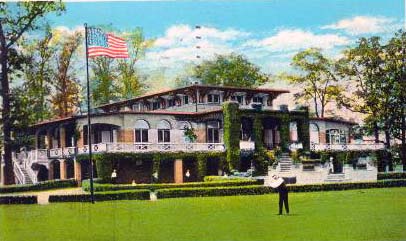
The other grand opening in 1912 was the Homeopathic State Hospital, which opened on October 3 at a cost of $1,931,270, and the number of patients quickly rose to 867, many of whom were transferred from the Norristown and Danville State Hospitals, which were overcrowded. The homeopathic approach to mental illness gradually evolved to a more standard medical approach and the word, Homeopathic, was dropped from the name. The hospital became known simply as the Allentown State Hospital.
Also in 1912, Dr Klotz opened the precursor to Union Blvd, the Allentown Bethlehem Blvd. This street was previously known as Klotz Ave. What its western and eastern limits were at this time are unknown.
By this time, a few more small businesses had also established themselves. One was the store owned by Frederick Bambach, which was located on Texter Ave. (Sherman St, north of Hanover Ave). The building still stands today, and Bambach went on to open a larger grocery store and restaurant on Union Blvd a couple of decades later.
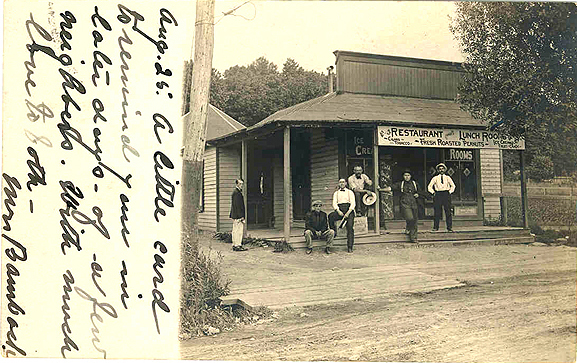 |
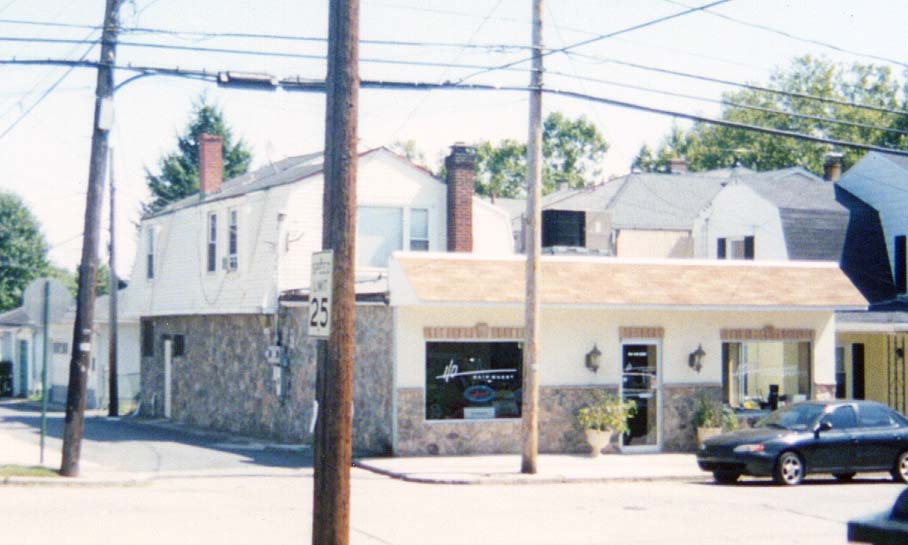 |
Bambach's Store on Texter Ave. |
The Site on Sherman St today |
Rittersville also had another grocery open by this time. That was the store opened by my great-grandfather, William Hoffert, and run by my great-grandmother, Emma Flores Hoffert. The store was located at 1909 Hanover Ave. and the building still stands today. An embarrassing part of the family history is that William Hoffert was a bit of a gadfly. He decided to not pay the taxes on his store and subsequently lost it in a sheriff's sale.
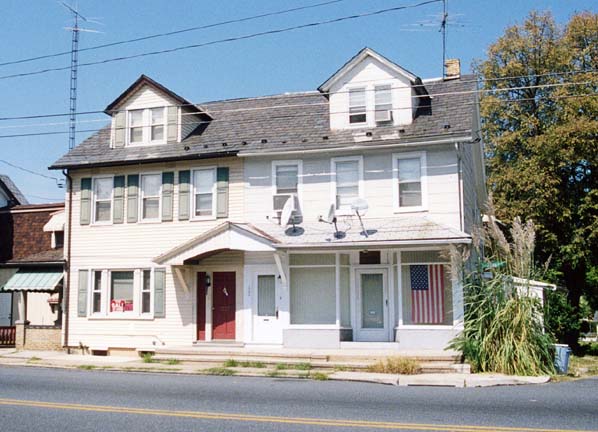
Another local entrepreneur was George L Knauss, who had the Novelty Machine Works, and the Prairie State Incubators business. He was located on the north side of Hanover Ave. or West Broad St.
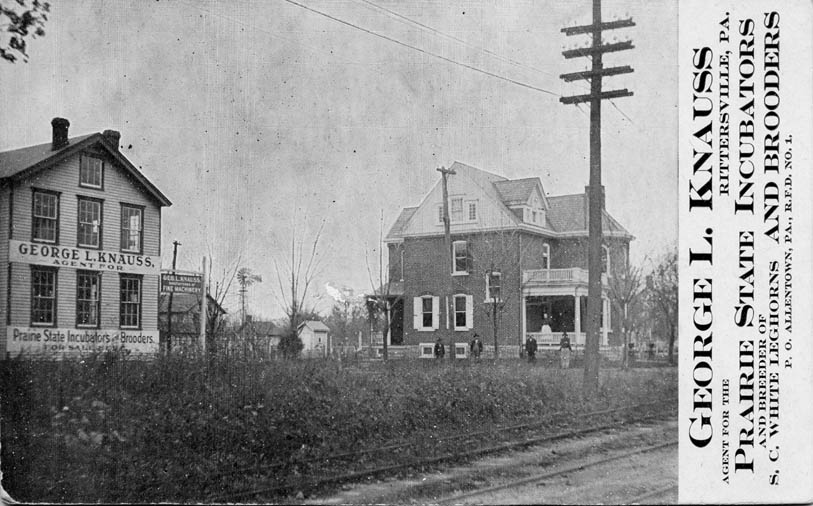
Some idea of the make-up of the village around 1914 can be gleaned from The Farm Journal Illustrated Farmers' Directory of Lehigh County, published in 1914. The published data shows that of the approximately 1,800 acres that comprised Rittersville, 654 acres, about 36%, was in the hands of 30 residents, and 23% of the total was owned by just three individuals: Dr. Klotz, the real estate developer, and farmers Penrose Mertz and Preston Sterner. These three individuals accounted for a little more than 400 acres among them. There were also 41 horses and 53 cattle in the village. Preston Sterner, who ran a farm and dairy, owned the majority of the cattle with 32 head. The other cattle were kept by farmers or individuals for their personal milk supply. Half the horses were owned by farmers. The others provided personal transportation or were needed in businesses, such as those of teamsters, hucksters, and milk dealers.
A big event in 1914 was the building of St Peter's Lutheran Church. The original St Peter's Union Church on Church St (Tacoma St.) was a Lutheran and Reformed church which had two separate congregations and organizations. At some point in the early 1900's, the Lutheran congregation decided to break away and form its own church. As a result, St Peter's Lutheran Church was built on Hanover Ave, on the corner of where Tacoma St intersects today. The church was dedicated on October 4, 1914. Around the same time, the St Peter's church on Tacoma also built a new church.
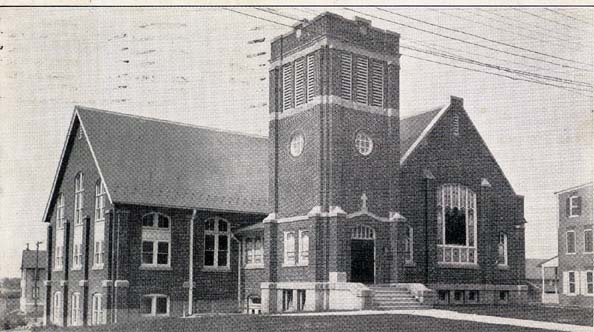 |
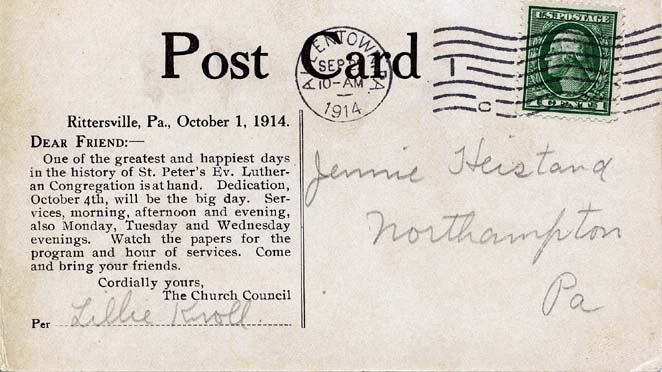 |
St Peter's Lutheran Church - 1914 |
Invitation to the Dedication |
By 1915, with the increase of residents in both Rittersville and East Allentown, and the increase in use of the automobile, the City of Allentown saw the need to widen and pave the old turnpike. It was double-tracked for trolleys, narrow, and there were no sidewalks. Frequent auto-trolley, and trolley-pedestrian accidents caused residents to call the road, "the bloody highway". Many residents opposed the idea, but by 1918, the highway had been rebuilt, though many considered it to still be too narrow. Along the route, it was not uncommon for whole rows of houses to be lifted up and rolled back from the highway to make room for expansion of the road.
By 1918, Rittersville even had a car dealership. The Hanover Garage was at 905 Hanover Ave. just east of Irving St. At the 1918 Allentown Car Show, the Hanover Garage displayed the new Crow-Elkhart open touring car.
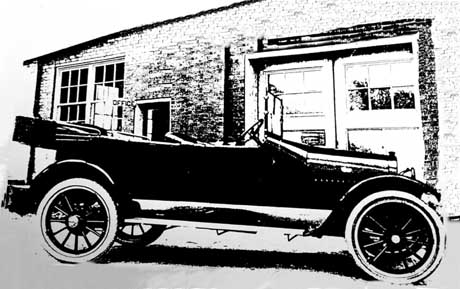
Also by 1918, in recognition of the growth of the motorcar, the Lehigh Valley Traction Company turned its baseball field across from Central Park into a parking lot and semi-real estate development.
By 1919, the year before annexation, Rittersville had more than doubled its population from 1903. The population had grown 121% in those 16 years, to 1,625 residents. Even without the unincorporated area of West Bethlehem, Rittersville comprised 1,786 acres, or about 2.8 square miles.
By 1919, there were a significant number of businesses based in Rittersville: American Hotel, Bambach's groceries, DeCeasar groceries, Eagle Chandelier Works, George Weisel Marble Works, Hanover Garage, Hanover Hotel, State Hospital, JM Snyder & Son lumber company, JF Horn & Sons florist, Klotz & Bregenzer, Manhattan Hotel, Charles Middaugh confectionery, Oscar Mack diary, Osenbach & Kramer, Park Place Poultry Farm, Peter's Grocery, Rothrock Brothers wheelrights, Royal Knitting Mills, Seifert Funeral Home, Shipe & Hoover cement contractors, Sunnyside Squab Loft, The Weneck Mills, and of course, Central Park, whose attendance was breaking records. In 1911 alone, they claimed their attendance was 630,000 for the season. (see Rittersville Businesses)
In the scheme of things, Rittersville was ripe for annexation, and Allentown, in its quest to hit the 100,000 population mark, was a ready suitor. It should be no surprise that Dr Robert Klotz was in the forefront of the push for annexation. and on February 16, 1920, Rittersville became Allentown's 15th ward.
©2005, 2013 Robert M Reinbold Jr